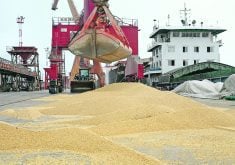Rage all you want about Ottawa favouring eastern automobile manufacturing industries and sacrificing farmers, but the new economic realities that brought the huge Canadian tariffs on Chinese electrical vehicles and the outraged response against Canadian canola by China aren’t changing any time soon.
Industrial policy and friend-shoring lie at the soul of the new world order of trading for rules-following countries.
It’s a form of free-trading among those who share a commitment to open trade, and a pushback against countries that flagrantly breach World Trade Organization rules and other multilateral and bilateral deals.
Read Also

Flax sector sees omega-3 opportunity
SASKATOON — A global shortage of omega-3 oils could be an opportunity for the flax sector, says an industry official….
On the “countries you can deal with” side are Canadian trading partners such as the United States, the United Kingdom, the European Union and the nations of the Comprehensive and Progressive Agreement for Trans-Pacific Partnership.
They might play fast and loose with some rules at some times, as does Canada, but in the end, all are willing to resolve their disputes through the various rules-based mechanisms we have created.
On the other side are those that can’t be trusted to eventually submit to the trade rules to which they have agreed. Chief among these is China, which is aggressive in its weaponization of trade in geopolitical relations.
The clearest and most compelling explanation of this new reality has just been broadcast on Bloomberg’s Odd Lots podcast, in which U.S. Trade Representative Katherine Tai not only lays out the broad outlines of this new reality, but directly discusses China’s actions against Canada, as well as the successes and failures of the North American Free Trade Agreement and the new U.S.-Mexico-Canada Agreement. I recommend you all listen to this episode.
Tai isn’t shy to call out China’s actions against Canada.
“It’s basically bullying at the highest level, in terms of a country taking its economic tools and bullying another one for exercising economic rights that are within its sovereign power to exercise,” said Tai.
Tai says the electric vehicle situation is one in which “we’ve seen Canada take measures that actually align their economic defences with ours … in order to protect our North American economy from the distortive effects of this unbridled, non-market-based Chinese excess production impacts on our competitiveness and frankly our ability to continue to produce, to be able to thrive, to have our producers in terms of EVs, in terms of steel and aluminium, to be able to grow, to survive in the first place.”
It’s a relief for Canadians to hear Tai say that the notion of autarky — economic self-sufficiency of one country alone — isn’t what the U.S. government wants. Closing off the U.S. to imports from all sources isn’t in the cards.
What the U.S. administration does want is much greater supply chain independence from countries such as China that threaten to use economic means to undermine geopolitical competitors.
As part of USMCA, Canada plays a vital role in that independence.
Mexico is also part of that deal but plays a murkier role due to its weak labour and environmental protections, which have allowed it to undercut American and Canadian workers, causing downward pressure on wages and large losses of jobs.
Tai said USMCA allows the members to challenge each other if they fail to allow for workers to unionize or otherwise protect themselves, something the U.S. has done with Mexico 30 times already. That should strengthen North America as a fair-trading alliance.
When it comes to offshore trading partners, the desire to work with like-minded competitors remains. However, this time there is also a focus on reversing the recent decades of globalization in which the “race to the bottom” allowed open market economies to be hollowed out by countries abusing workers and the environment.
“We are in an inflection point right now, where I think we are really evolving into the next version of globalization,” Tai said.
That includes working with countries that improve workers’ rights and environmental protection, in which trade boosts both in a “race to the top.”
The good news in this for western Canadian farmers is that the U.S. economy is their biggest and best paying market, the lax labour and environmental practices in some countries undercut farmers’ competitiveness, and while China might be at least momentarily infuriated by Canada’s alignment with the U.S. on electric vehicles, the U.S. has certainly noted Canada’s co-operation and trustworthiness.
Successive Canadian governments have learned that dealing with China is fraught with danger. On trade, it has become apparent anything beyond cash-on-the-barrelhead commodities sales is risky and inherently undependable. For similar reasons, dealing with India, Russia and other interventionist states will also be unreliable.
However, being onside with the U.S. and building toward a trade bloc of rules-following nations is farmers’ best bet for strong underlying markets.
Fights with China and other similar nations will continue to erupt in this new age of friend-shoring and industrial policy. Canadian farm products will be targeted. That was going to happen anyway.
At least, if Tai’s comments are accurate, Canadian farmers might be part of a growing new form of globalization that removes some of the perils of the old system, while strengthening friendships into the future.
















